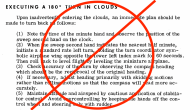Author Doug Stewart is a former Executive Director of SAFE. He is also a full-time flight instructor, DPE, and thirteen- time Master Instructor. He is the 2004 National Instructor of the Year. He has provided more than 13,300 hours of dual instruction. Original PDF

Pilots who inadvertently fly from VMC into IMC conditions frequently end up in a fatal accident. Anyone who has taken the time to review the fatal accident statistics found in the Nall Report or in the NTSB records can see this is true. Further, the rate and percentage of VMC–into-‐IMC fatal accidents has not decreased in any significant fashion in many years. Thus the question comes to mind: “Why have we not been able to improve these statistics and effectively teach pilots the proper strategies to keep them from needlessly killing themselves?”
From my experiences and perspective as an instructor and designated examiner, the answer is simple and twofold. The first part is due to the immutability of the “rule of primacy:” The things we learn first are the things that stick and are hardest to unlearn. Many CFIs are not teaching the first three hours of basic instrument attitude flying using realistic scenarios in their curriculum, nor are they teaching safe IMC escape strategies.
Wrong Mindset Leads to Disturbing Statistics!
Inaccurate instruction leads to a mentality among newly minted pilots that flying in the clouds is not difficult and that inadvertent IMC is relatively easy to escape. Unfortunately, neither of these are true. Looking at the statistics we quickly see the lethality of inadvertent IMC encounters.
The most recent 22nd Nall Report shows that whereas barely 5 percent of all accidents occurred in IMC, these accidents accounted for 18 percent of the total fatal accidents. Of the 43 weather-‐ related fatal accidents, 67 percent were attributed to VMC into IMC. Almost two-thirds of all IMC accidents were fatal compared to about 15 percent of day-‐VMC and 20 percent for night-‐VMC.

From the NTSB database covering the years from 2003 – 2012, there were 1,100 accidents identified and reviewed as IMC accidents, 319 of which were identified as VFR flight into IMC. Of those accidents that reported environmental or weather factors: 126 involved low ceilings; 62 involved clouds; 58 had fog as a factor, and 40 were below VFR minimums. Said another way, just short of 90 percent of weather-related accidents had low ceilings and low visibilities as a major factor. The statistics clearly point to the problem.
The Current Flawed Instructional Method
Let’s look at some of the problems with how basic attitude flying is most often taught. Ideally, student pilots have already received some ground instruction on a proper instrument scan prior to their first “instrument” lesson in the airplane. If their instructor has been negligent in providing this, then hopefully the pilot has studied on their own. And sad to say, there are probably some learners whose initial introduction to the “hood” came as a total surprise when the instructor grabbed the controls and instructed the client to put on some kind of ill-fitting view-‐limiting device.
Regardless of how the student pilot arrived at that point during a flight lesson when they first experience flying “on the gauges,” the experience is that of one moment seeing the glorious world from the vantage point of an airplane and the next, seeing nothing but a panel full of confusing instruments that might not be making any sense. For the next three hours of their instrument instruction required for the Private Pilot certificate, whenever they have to put on the “foggles,” their encounter with simulated IMC is an instantaneous one, so unlike the real-‐world encounter that might someday take their life.
The learner’s first hour of instrument instruction will most likely consist of the basics: straight and level; turns, both left and right (and unfortunately usually at standard rate); constant speed climbs; constant speed descents; and perhaps recovering from unusual attitudes. Then for the next two hours of instruction (it’s rare that I find applicants for a Private Pilot Certificate with more than a tenth or two more than the minimum 3 hours required) it’s more of the same with perhaps less and less coaching. Hopefully at some point in the course of learning, the instructor will discuss what to do if the pilot inadvertently flies into a cloud.
Where We Fail Our Learners
 This is the point where we are most profoundly failing our learners. Not only are we not teaching scenarios that realistically represent how pilots get caught in IMC, but we are also teaching unsafe exit strategies. Instructors seldom discuss the real situations that lead to inadvertent IMC encounters. It seems that way to me, based on the reactions of some of the Private Pilot applicants I’ve tested. When I ask: “OK – you just realized you can’t see the ground anymore… what are you going to do?” it’s as if it’s the first time they’ve ever considered the problem.
This is the point where we are most profoundly failing our learners. Not only are we not teaching scenarios that realistically represent how pilots get caught in IMC, but we are also teaching unsafe exit strategies. Instructors seldom discuss the real situations that lead to inadvertent IMC encounters. It seems that way to me, based on the reactions of some of the Private Pilot applicants I’ve tested. When I ask: “OK – you just realized you can’t see the ground anymore… what are you going to do?” it’s as if it’s the first time they’ve ever considered the problem.
Not only is the learner pilot not taught the “why” of the lesson, but to add insult to injury, they are taught a potentially unsafe exit strategy… that being an immediate 180-‐degree turn, at standard rate. In fact, I once heard a highly regarded instructor state: “If a pilot is not instrument rated and proficient, the only logical maneuver to perform is the 180v degree turn.” It is this advice that leads to the loss of control or CFIT accident that is killing so many pilots!
Consequently, many student pilots finish their primary training with the rule of primacy reinforcing two erroneous conceptions: 1. IMC encounters are instantaneous; and, 2. The only exit strategy is an immediate 180˚ turn.
Let’s discuss a more realistic and holistic approach to teaching our learners to not only have a way of safely exiting an IMC situation but perhaps more importantly how to avoid the situation in the first place.
Teaching Inadvertent IMC Correctly
 Prior to teaching the techniques of an effective instrument scan we need to discuss with our clients how these encounters happen in the real world. Most pilots who have inadvertent IMC encounters don’t just suddenly and unexpectedly fly into a cumulous cloud at altitude. The real scenario is most typically one of lowering ceilings and visibilities as the pilot endeavors to reach their destination. As the ceilings lower, the pilot slowly descends, quite often not noticing that the visibilities are decreasing along with their altitude. At some point, the pilot recognizes that if they continue their descent it might end up as a CFIT accident so they level off and get closer and closer to the cloud bases and reduced visibilities. Finally, they realize they have lost sight of the ground, and can no longer fly the airplane using visual reference.
Prior to teaching the techniques of an effective instrument scan we need to discuss with our clients how these encounters happen in the real world. Most pilots who have inadvertent IMC encounters don’t just suddenly and unexpectedly fly into a cumulous cloud at altitude. The real scenario is most typically one of lowering ceilings and visibilities as the pilot endeavors to reach their destination. As the ceilings lower, the pilot slowly descends, quite often not noticing that the visibilities are decreasing along with their altitude. At some point, the pilot recognizes that if they continue their descent it might end up as a CFIT accident so they level off and get closer and closer to the cloud bases and reduced visibilities. Finally, they realize they have lost sight of the ground, and can no longer fly the airplane using visual reference.

Now they revert to what they learned in their primary training… they make a 180-degree turn. But having never done this in real IMC, and further, by banking into a typically taught standard rate turn, they lose control. Consider the newly rated pilot in a Cirrus SR22 cruising at 180 knots. [Yes… there are more pilots out there in this type of aircraft than you might think…] The bank rate for a standard rate turn at that airspeed is slightly more than 26 degrees. For a pilot who is experiencing IMC for the very first time, this could be considered a steep turn.
If the pilot has gotten into this situation by descending in order to try and maintain visual conditions, now, if they do manage to maintain control as they turn, they unfortunately die in a CFIT accident as they turn into terrain or an obstruction.
We need to teach our clients how to recognize deteriorating weather and to make a diversion turn while they still can remain in visual conditions. If at all possible, give them the experience of flying in marginal conditions. With a good ATD or simulator, this should be easy, but if you do not have access to this great training technology, there will still be days when rather than canceling a lesson because of low (but legal) visibilities you can take advantage of the conditions. Take your client up for a dual flight when the visibilities are between 3 -‐5 miles.
Let them experience how the closer to the clouds they get, the poorer the forward visibility becomes. The lesson does not have to be long, but it will be invaluable in teaching the dangers of flying in reduced visibilities.
The Details: Control, Climb, Communicate…
Also consider filing a short IFR flight on a day when you might otherwise cancel your session with a client because of IMC conditions, and take them up to experience the real thing. Request a block of airspace from ATC and then have your client fly the four fundamentals without any outside references. Consider taking your client through a recovery from an unusual attitude in IMC as well. This experience might very well save their life in the future.
First, we need to teach our clients to recognize deteriorating weather while they still have the opportunity to fly visually and to make that immediate 180-‐degree turn˚ while they can still use visual references and at a safe altitude. Then we need to teach them a safe way to exit IMC if they do end up there inadvertently. Here is what I suggest.
The first thing they need to be taught is to not panic but do their best to trim for and maintain straight and level flight by using the scan techniques you taught them as a student pilot. and to get comfortable with the Five Cs: starting with Controlling the airplane solely by reference to the instruments. Teach them next to Climb. We all know the saying there’s nothing as useless as altitude above you…. If ever there was a time and place for this to be applicable it’s in this situation.
Now if we have properly taught them how to conduct a constant speed climb, they will hopefully know that the trim will maintain an angle of attack that if unchanged will also maintain airspeed. So to climb, the only control that needs to be touched is the throttle, and by adding power, along with a little right rudder as necessary to maintain heading, the airplane will climb at the same airspeed as when they were level.
With increased altitude there’s not only less of a chance of a CFIT encounter but also a much better chance to be seen by radar, and to be heard on the radio. Thus, once they have leveled off, by reducing power back to their cruise power setting, teach them to Call for help and Confess their situation to ATC. (I advise my clients to declare an emergency because it is!) Your clients need to know that ATC will do everything in their power to guide the errant pilot to VMC conditions.
They now need to Comply with ATC instructions. If ATC tells them to turn, (and it’s rarely a 180-‐degree turn), hopefully, you have taught them that their steepest bank should not exceed 10-‐degrees.. With a shallow bank, they will have a much easier time maintaining altitude and much less likelihood of losing control. After all they are not in a race to get turned around, and a steep bank has a much better chance of getting them into a race into the ground.
When ATC tells them to descend, again, only one control needs to be touched to yield a constant speed descent… the throttle. Reducing power will provide a descent rate of approximately 100 FPM for every inch of manifold pressure, or 100 RPM for fixed pitch props.
In closing, let’s remember that although inadvertent flight from VMC into IMC is not the biggest killer among GA accidents, it has the greatest potential to end in a fatal accident. The things we teach our clients in their early days of training are going to be the things they retain. Thus, we have a responsibility to teach our learning pilots not only the safest way to exit IMC conditions but probably more importantly how to recognize real-world deteriorating conditions before they are encountered and provide them with the tools they need to make disciplined, good decisions. If we can do that we will go a long way in reducing the number of fatalities resulting from inadvertent VMC into IMC

Join us this Sunday March 23 for a free webinar on flying the CFI initial evaluation. This demonstrates the “split-brain aptitude” of flying, talking and avoiding danger while in the air. CFI-PRO™ provides the “Missing Manual” of how we really teach. 



